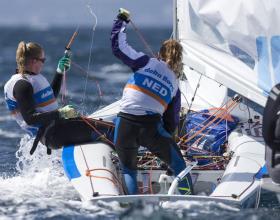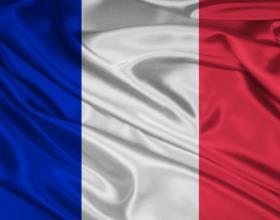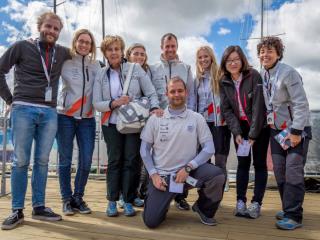Diabo News
Lessons learned from the Volvo Ocean Race
'What have you learned from your Volvo Ocean Race experience”, asked a member of the Lions Club Leiderdorp after my presentation in September. Good question! I guess quite a lot. It has been almost four months since the 2014-15 Race finished in Gothenburg, so it is time for some reflection.
It was a long and intense journey with nine colleagues around the world. We formed an international team of national media managers, managed by News and Media Director Jon Bramley from the Volvo Ocean Race. I took care of the Dutch media, so I carried out the media strategy in the Netherlands, wrote the Dutch press releases and interviews, assisted the Dutch media, monitored the publications as much as possible and reported on location in Alicante, The Hague and Gothenburg.
My contract started back in October 2012 with the announcement of the new One Design class coming up. The pre-race period was full on, because of the introduction of several changes to the former format, such as the Boat Yard (shared service center). We followed the building process of the inaugural Volvo Ocean 65’s and looked for media affiliates in our own countries. In the end we worked with 55 affiliates in our 10 countries. Per key market, we put together a list of Hot 100 media titles outside the sailing sports. We had a KPI of 60,000 online articles in total, to be published in that Hot 100 list, which meant one per week. The pressure was on!
The objective for the 2014-15 edition was: Stories of human endeavour will grow our fan base and support sponsor objectives. Without compromising our love for sailing.The idea was to find growth amongst the so called ‘urban connectives’, people who were born in the late sixties or early seventies. They are educated, sportive, having a career and trying to get the most out of their lives. They grew up with BMX, surfing, skateboarding, etc., but most important they are connected and are believed to share the ‘wow factor’. I found it a bit abstract, but at the same time it was a challenge that pulled me out of my comfort zone of pure sailing fans.
We held a weekly ‘webex call’ in order to discuss the progress and actions for that coming week and furthermore we were connected through skype groups. For the first time since 11 years I was part of a larger team, directed by HQ, throughout such a long period of time, which was very interesting. Our first meeting in person was at the Volvo Ocean Race Ports and Teams Conference in April 2014 in Alicante, followed by the start in October 2014. One of the biggest changes for me professionally was the focus on the whole fleet and no longer on just one team, like I was used to as traveling press officer of Team Delta Lloyd in the 2008-09 Volvo Ocean Race. Another one is the fact that I worked from home, far away from boats, sailors and race villages. I missed that real contact as an inspiration. In the end, I became a sailing journalist because I love being around people and reporting on what I hear, experience and see.
Dutch media
In order to meet the communications objective in the Netherlands, I tried to ‘sell’ dedicated story lines to parenting and women magazines, professional communications media, traveling magazines, environmental magazines, morning TV and Radio shows, evening talk shows, weather bulletins, digital media magazines, etc. The outcome was a bit disappointing, as many editors would still consider the Volvo Ocean Race as ‘too far away from the reality of their readership’. In other words, too elite. I found it really hard to bridge that gap, despite the wonderful stories of Team Brunel, representing the Netherlands, Team SCA watch captain Carolijn Brouwer (NED) and initially Wouter Verbraak (NED) of Team Vestas Wind.
However, with the grounding of Team Vestas Wind on a reef in the Indian Ocean with Dutch navigator Wouter Verbraak in the leading role, all mainstream media woke up. All of a sudden Wouter became the most wanted man for Dutch yachting and sports journalists, but we had to deal with the team’s board and legal affairs regarding the insurance. Just before Christmas, Wouter came to the Netherlands and talked to the Dutch press through a media conference call. Not the ideal situation, but at least he could share his experience with the Dutch media and answer some questions. For me as Dutch Media Manager, this unfortunate accident was of course a huge happening. Personally, I think that Wouter made the most of it. The way he dealt with this situation was amazing.
Another memorable moment was the leg victory of Team SCA. On the morning of the leg start, I released an interview with Carolijn Brouwer. I quoted her in the title: 'I think that my expectations were too high.” She was, as always, honest and open about their disappointing performance so far. Only a few days later they finally won an offshore, the first one by an all female crew in 25 years. My PR work has never been so easy.
Last but not least, the The Hague Pit-Stop made my race. The local organization showed off with a mind-blowing event, that surpassed all expectations. It commenced with a long and cold night of the arrivals. The harbour heads were packed, people came from all over the country and the media room remained crowded. Some journalists from outside the sailing sports were surprised by the beauty of this Race. The following evening, all Dutch (and the only Belgian) sailors were honored on stage. They were treated as true heroes. On the day of the re-start, ten thousands of visitors came to Scheveningen. Local authorities even had to close the Race Village. It was unbelievable. The way the Dutch public waved the boats goodbye was impressive. The aerial shots say it all.
So, what have I learned from this 12thedition? Well, it remains difficult to raise media interest (outside yachting and sports) for professional sailing. Even if it concerns the most extreme yachting race around the world. That made it hard to find the urban connectives. At the same time, I have seen the enthusiasm of so many Dutch citizens, so there is absolutely room for further growth. If I get another chance to work for this wonderful Race, I will definitely put more effort in finding the right ambassadors in the Netherlands. Speaking for myself, I am more of a ‘people person’, so I need to get out in the field once in a while.
More news
Nederlands
English
- 1 articles (EN)
- 1 articles (EN)
- 1 articles (EN)
- 2 articles (EN)
- 1 articles (EN)
- 4 articles (EN)
- 1 artikelen (NL)
- 10 articles (EN)
- 3 artikelen (NL)
- 8 articles (EN)
- 9 artikelen (NL)
- 14 articles (EN)
- 24 artikelen (NL)
- 5 articles (EN)





